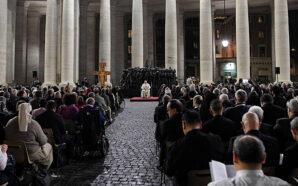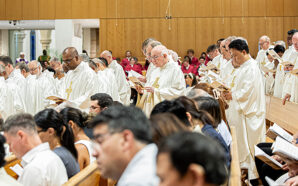When Mary Ellen Mitchell first heard about Beacons of Light—a plan by the Archdiocese of Cincinnati to arrange its 208 parishes into 57 “families of parishes”—she felt confident that Bellarmine Chapel, her own parish of 13 years, would not be affected. The family parish model combines previously independent parishes together under one pastor with the eventual goal of becoming a single canonical parish. She assumed the plan mostly would apply to struggling parishes.
Bellarmine Chapel, a Jesuit-run parish in Cincinnati, is a vibrant faith community where approximately 1,000 people attend Mass each weekend, so Ms. Mitchell was surprised when she learned that under the new plan, Bellarmine would be sharing a pastor with St. Xavier Church, another Jesuit parish. Still, she assumed the alliance would be mostly on paper.
In August 2023, Paul Lickteig, S.J., was made responsible for the administration of both parishes, and the changes began. Rather than two part-time business managers, the parish family has one, full-time business director. A staff member who previously worked on social mission at one parish was made responsible for sustainability and social mission at both parishes, and an assistant staff member was hired to work on social mission at each parish. The parishes began co-advertising events, and the parish councils began holding joint meetings.
As the reality of the changes unfolded, Ms. Mitchell became more enthusiastic. “It just made sense,” she said. “This was an opportunity to restructure.” She said the staff changes have allowed for new opportunities for parishioners, too. Ms. Mitchell recently brought a group of high school students to a Saturday evening Mass at Xavier—at a time not offered at Bellarmine—and to a Eucharistic adoration evening there, an event she wouldn’t have been aware of before the parishes joined forces.
The parish family structure has “given us wider breadth to participate in things and still feel like we’re not leaving our parish,” Ms. Mitchell said. “The fact is this is all our parish now, and we have two locations. If you think of it like that, your church is suddenly offering a lot more.”
The desire to use church resources responsibly—including buildings, parish funds, staff and priests—has caused many dioceses and archdioceses across the county to embark on similar initiatives to reimagine church structures, both physical and administrative. These strategic planning processes are attempts to address the fact that the resources available to many of those communities have begun to dwindle.
To continue reading this article, click here.
Kerry Weber is an executive editor for America.
With thanks to America and Kerry Weber, where this article originally appeared.








